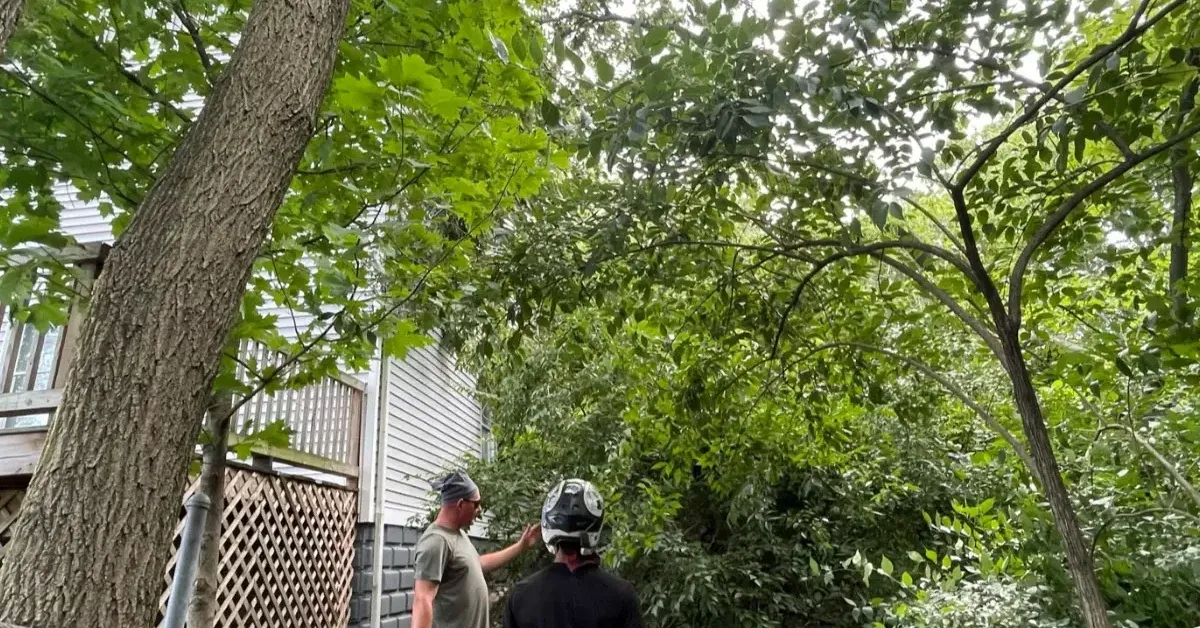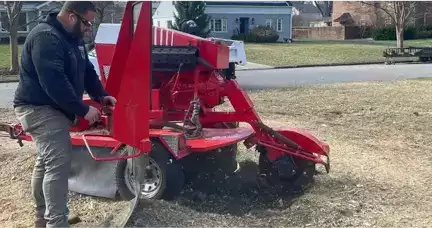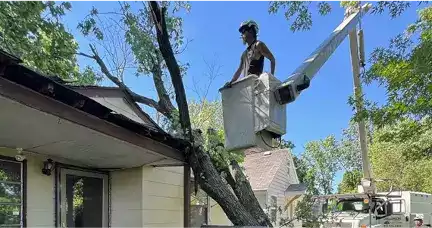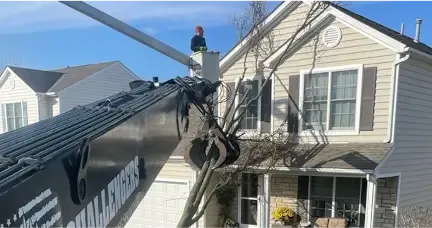When branches from your neighbor’s tree stretch across your property line, it can cause more than simple frustration. Those limbs can drop leaves on your lawn, block sunlight in your garden, or even cause damage during storms. The question comes up often among homeowners: Who’s legally responsible for those overhanging branches?
This in-depth guide from Challengers Tree Service explains your legal rights, property responsibilities, and practical solutions to handle the issue without turning it into a neighborhood conflict.
Understanding Who Owns the Tree and Where Responsibility Starts
Property ownership plays a key role in determining who is responsible for tree maintenance. A tree is generally considered the property of the person whose land the trunk sits on. However, when the branches or roots extend beyond the property line, the situation becomes more complex.
If branches from your neighbor’s tree hang over your yard, you have the legal right to trim them back to the property line. However, you must not cause harm to the tree or enter your neighbor’s yard without permission. If your trimming damages or kills the tree, you could be held liable for the cost of replacement or damages.
Important Tip: Always confirm where the exact boundary line lies before taking action. Property surveys or markers can help avoid disputes.
What Local and State Laws Say About Overhanging Branches in Central Ohio
In Ohio, property owners generally have the right to trim branches or roots that extend over their property line. This is known as the right of self-help, allowing you to maintain your space as long as your actions do not damage or kill the tree. However, this right comes with limits. You can only trim up to your property boundary, and any work should avoid harming the tree’s overall health or stability.
If the tree is protected by a local ordinance or located on city property or an easement, you must get approval before pruning. Many Central Ohio municipalities, including Columbus and nearby areas, enforce urban tree protection rules that require permits for work affecting public trees or specific species.
Violating these laws can result in fines or civil penalties, so it is always best to check with your city’s code enforcement office or consult a certified arborist before doing any trimming.
When Overhanging Branches Become a Safety Hazard
Overhanging branches is not just an aesthetic concern. They can cause significant property damage or personal injury. Here are some common risks:
- Falling branches: Weak or dead limbs can fall during storms and damage vehicles, fences, or roofs.
- Power line interference: Branches touching or leaning near power lines pose fire and electrical hazards.
- Root intrusion: Roots that extend underground can crack driveways, lift sidewalks, or damage foundations.
- Blocked sunlight: Heavy overhang may affect lawns, gardens, and solar panels.
If you suspect an overhanging branch is hazardous, contact a qualified arborist for inspection. Professional assessment helps determine whether pruning, removal, or cabling is necessary.
How to Approach Your Neighbor About Overhanging Trees
Tree disputes between neighbors often begin with poor communication. Before taking action, try to resolve things calmly. Here’s a simple process that works:
- Start with a friendly conversation. Explain the issue and share your concerns about safety or property impact.
- Show documentation. Take photos showing where the branches cross the property line or cause damage.
- Offer solutions. Suggest splitting the cost of trimming or hiring a professional together.
- Get agreements in writing. Even a simple email or signed note helps prevent future misunderstandings.
If the neighbor is unresponsive or refuses to cooperate, document your attempts to resolve the issue and consult local regulations before taking further steps.
When You’re Liable for Tree Damage
Responsibility for tree damage depends on the tree’s condition and the situation in which the damage occurred.
- Healthy trees: If a healthy tree or branch falls during a storm and damages a neighbor’s property, it is usually treated as an act of nature. In most cases, the affected homeowner’s insurance covers the damage.
- Neglected trees: If a tree is dead, diseased, or clearly hazardous and causes damage, the property owner can be held responsible.
- Ignored warnings: If a neighbor has warned you about a dangerous tree and you chose not to act, you may be liable for any resulting damage.
Proper tree care not only keeps your property safe but also protects you from unexpected financial and legal problems.
When to Call Professional Tree Service
Large branches, tall trees, or limbs near structures should never be handled by homeowners without experience. Challengers Tree Service provides professional trimming and removal to prevent accidents and ensure safety.
Professional arborists use advanced equipment to:
- Remove branches safely without harming the tree
- Prevent property damage from falling limbs
- Improve tree balance and structure
- Maintain clearance from roofs and utilities
Attempting to trim tall or heavy branches on your own can cause severe injury or property damage. Always rely on experts when dealing with complex or hazardous situations.
Preventing Overhanging Branch Problems in the Future
Proactive care is the best way to prevent disputes and damage. Here’s what homeowners can do:
- Schedule annual inspections to catch structural weaknesses early.
- Trim regularly to maintain shape and clearance.
- Avoid planting large trees too close to property lines.
- Discuss planting plans with neighbors before installation.
- Keep records of all tree work, including invoices and photos.
A healthy, well-maintained tree adds value to both properties and reduces long-term maintenance costs.
What to Do if the Tree Is Dangerous
If you notice a tree leaning toward your home, splitting near the base, or shedding large limbs, treat it as a serious hazard. Notify the property owner immediately, and take photos for documentation.
If the owner refuses to act, you can contact your local municipality. Some areas allow you to file a formal complaint with code enforcement or public works if a private tree threatens safety. Always prioritize personal and property safety over hesitation to report.
Common Scenarios Explained
| Scenario | Who’s Responsible |
| Branches overhanging your yard | You can trim up to the property line on your side. |
| Tree roots are lifting your driveway | You can cut roots on your side if it doesn’t kill the tree. |
| A tree falling during a storm | Usually, an act of nature, a property owner files insurance. |
| A dead or neglected tree falling | The tree owner can be held liable for negligence. |
| Tree on shared property line | Both owners share responsibility for care. |
What Happens if You Damage the Tree
Trimming too aggressively or cutting beyond your property line can result in fines or civil penalties. Courts often hold the person who caused harm financially responsible for the tree’s value. Depending on species and maturity, tree replacement costs can run into thousands of dollars.
Before any major work, it’s smart to consult both your neighbor and a professional arborist. They can provide documentation proving that your actions were reasonable and in compliance with safety standards.
Signs a Tree Is Encroaching on Your Property
You might not notice overhanging branches until they start causing problems. Watch for these early indicators:
- Branches brushing against your roof or gutters
- Root heaving near fences or driveways
- Excess shade over garden areas
- Heavy leaf or debris buildup each season
Catching these signs early allows for minor pruning instead of major removal later.
Tips for Homeowners
- Inspect trees after heavy winds or storms.
- Look for cracks, decay, or pest infestation.
- Trim trees during the dormant season for less stress.
- Keep at least 10 feet of clearance between branches and your roof.
- Never use climbing spikes on living trees; they cause long-term damage.
Following these steps extends the lifespan of your trees and prevents unwanted conflicts with neighbors.
Frequently Asked Questions
Can I trim my neighbor’s tree without permission?
Yes, you can trim branches that extend onto your property, but only from your side of the line. Never step into your neighbor’s yard or damage the tree’s health, as that could make you liable.
What if my neighbor’s tree causes property damage?
If the tree was healthy and fell due to natural causes like a storm, your homeowner’s insurance usually covers the damage. If it was diseased or neglected, the tree owner may be responsible for repairs.
How can I prevent tree disputes with neighbors?
Good communication goes a long way. Talk openly about concerns, document issues with photos, and hire qualified arborists for safe, neutral solutions before small issues become conflicts.
Do I need a permit to trim large trees?
Some cities require permits for trimming or removing large or protected species, especially those near power lines or public areas. Always check local codes or ask your arborist before starting work.
What if the tree blocks my sunlight?
You can trim overhanging branches within your property, but loss of sunlight alone usually isn’t enough to demand full removal. It’s best to discuss shade concerns directly with your neighbor first.
Protect Your Property and Peace of Mind
Contact Challengers Tree Service in Central Ohio today for expert help managing overhanging tree branches and keeping your property safe and compliant with local laws.





